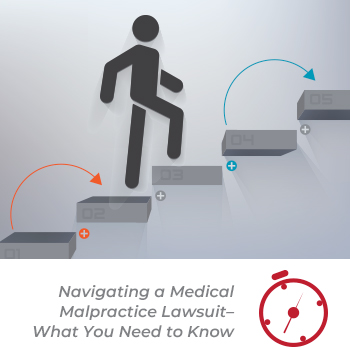
Though I tend to focus on birth injury medical malpractice cases, the type of injuries and specifics of each case vary widely. What stays consistent, however, is the lawsuit process. The 10 steps in a medical malpractice lawsuit can take years to complete.
Step 1: Initial Consultation
In your initial consultation with your trusted medical malpractice lawyer, you’ll have a chance to ask questions and provide information about your case. We may ask you about the details of the care that caused the injury and why you suspect medical malpractice is involved. We’ll also double-check the timing of the case to make sure the statute of limitations has not run out.
Step 2: Gather Records
Once we’re ready to move forward, you will be asked to sign a retainer and a contingency fee agreement, which details what the law firm’s fees and expenses will be if your case is won. We’ll also ask you to authorize us to obtain your medical records. Even with your authorization, it can take up to a year to get the records.
Step 3: In-House Investigation
With the help of our in-house medical team, we look for violations of standards of care and how they relate to your injury. We will also identify all potential defendants and consider possible obstacles we may encounter. The investigation will uncover whether your case should be pursued in court, and what other options may be available.
Step 4: Select Expert Witnesses
The next step is to line up expert witnesses in the medical field to support your case. They are given detailed information and records so they can prepare their expert opinions.
Step 5: Pre-Trial Phase
After the investigation and witness selection, the lawsuit moves into the pre-trial phase. This phase can last 18 months or more. We’ll continue to compile evidence, take your deposition and the defendants’, and resolve any legal issues and motions that arise.
Step 6: Settlement Negotiations
During the pre-trial phase, one side may approach the other with a settlement offer. It is okay to reject a settlement offer if it is not fair or reasonable. Your lawyer will handle the negotiations of the settlement.
Step 7: Trial
If no settlement is reached, the case goes to trial. Most trials are in front of a jury but some, including those involving federal employees, are heard by a judge alone. Medical malpractice trials typically last one to four weeks.
Step 8: Jury Deliberations and Verdict
After both sides rest their cases, the jury goes over the evidence and discusses the case to reach a verdict. If they do, the verdict is read in open court along with the award amount. But sometimes, the jury is unable to reach a decision, and a mistrial is declared.
Step 9: Post-Trial Motions and Appeals
The losing party has the right to appeal the jury’s decision. If the award seems outrageously high or low, either side may try to persuade the judge to make an adjustment or grant a new trial.
Step 10: Finalization
If your case is settled, you will sign an agreement that releases the defendant from future liability. This means you cannot pursue more money from the defendants if your condition worsens. However, if your condition improves, you are not obligated to return a portion of your award.
All medical malpractice lawsuits follow these ten steps, regardless of the specific details of the case. To learn more about the medical malpractice lawsuit process, seek the advice of a reputable personal injury lawyer.
RELATED POSTS
Our Lawyers Don’t Stop Fighting for Your Medical Malpractice Settlement Until Justice Is Served
